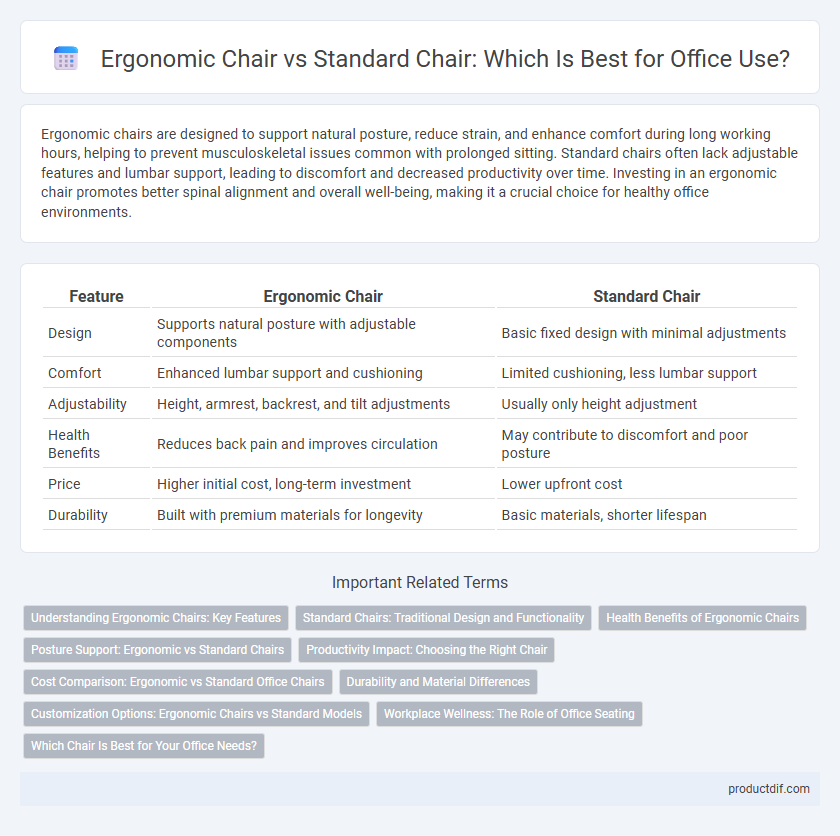Ergonomic chairs are designed to support natural posture, reduce strain, and enhance comfort during long working hours, helping to prevent musculoskeletal issues common with prolonged sitting. Standard chairs often lack adjustable features and lumbar support, leading to discomfort and decreased productivity over time. Investing in an ergonomic chair promotes better spinal alignment and overall well-being, making it a crucial choice for healthy office environments.
Table of Comparison
| Feature | Ergonomic Chair | Standard Chair |
|---|---|---|
| Design | Supports natural posture with adjustable components | Basic fixed design with minimal adjustments |
| Comfort | Enhanced lumbar support and cushioning | Limited cushioning, less lumbar support |
| Adjustability | Height, armrest, backrest, and tilt adjustments | Usually only height adjustment |
| Health Benefits | Reduces back pain and improves circulation | May contribute to discomfort and poor posture |
| Price | Higher initial cost, long-term investment | Lower upfront cost |
| Durability | Built with premium materials for longevity | Basic materials, shorter lifespan |
Understanding Ergonomic Chairs: Key Features
Ergonomic chairs feature adjustable seat height, lumbar support, and swivel capabilities designed to promote proper posture and reduce strain during long work hours. Unlike standard chairs, ergonomic models prioritize spinal alignment and customized comfort, enhancing productivity and minimizing musculoskeletal disorders. High-quality materials and contoured designs are essential components that distinguish ergonomic chairs in office environments.
Standard Chairs: Traditional Design and Functionality
Standard chairs, characterized by their traditional design, offer basic seating functionality with a focus on simplicity and affordability. These chairs typically lack advanced ergonomic features such as adjustable lumbar support or customizable seat height, which may result in less comfort during extended use. Suitable for occasional use, standard chairs remain a popular choice in offices with minimal ergonomic requirements or budget constraints.
Health Benefits of Ergonomic Chairs
Ergonomic chairs significantly improve posture by supporting the natural curve of the spine, reducing the risk of chronic back pain and musculoskeletal disorders. These chairs promote better circulation and reduce strain on the neck, shoulders, and lower back, enhancing overall comfort during long work hours. Compared to standard chairs, ergonomic designs decrease fatigue and increase productivity by minimizing physical stress and promoting healthier sitting habits.
Posture Support: Ergonomic vs Standard Chairs
Ergonomic chairs are designed to provide superior posture support through adjustable lumbar support, seat height, and backrest angles, promoting spinal alignment and reducing strain during long work hours. In contrast, standard chairs often lack these customizable features, leading to poor posture and increased risk of discomfort or musculoskeletal issues. Prioritizing ergonomic seating in office environments enhances employee well-being and productivity by encouraging healthier sitting habits.
Productivity Impact: Choosing the Right Chair
Ergonomic chairs are designed to support natural posture and reduce strain, which significantly enhances productivity by minimizing discomfort and fatigue during extended work hours. Standard chairs often lack adjustable features, leading to increased risk of musculoskeletal issues and decreased focus over time. Investing in an ergonomic chair improves employee well-being, resulting in higher efficiency and reduced absenteeism.
Cost Comparison: Ergonomic vs Standard Office Chairs
Ergonomic office chairs typically range from $200 to $1,200, offering advanced support features that reduce strain and enhance comfort during long work hours, whereas standard office chairs cost between $50 and $150 but lack customizable adjustments. Higher upfront investment in ergonomic chairs often leads to long-term health benefits and reduced absenteeism, potentially offsetting the initial price difference. Budget-conscious buyers might prefer standard chairs for short-term use, but ergonomic options provide better value for extensive daily office work.
Durability and Material Differences
Ergonomic chairs are typically constructed with high-quality materials such as reinforced steel frames and breathable mesh fabric, enhancing durability compared to standard chairs often made with basic plastic and lower-grade cushioning. The use of durable components in ergonomic designs ensures long-lasting support and resistance to wear under frequent use in office environments. Standard chairs generally lack specialized materials that improve lifespan and structural integrity, resulting in quicker deterioration over time.
Customization Options: Ergonomic Chairs vs Standard Models
Ergonomic chairs offer extensive customization options such as adjustable seat height, lumbar support, armrests, and tilt tension, enhancing comfort and reducing strain during long office hours. Standard chairs typically provide limited or no adjustability, focusing on basic seating functions without tailored support features. Investing in ergonomic seating can significantly improve posture and productivity by accommodating diverse body types and sitting preferences.
Workplace Wellness: The Role of Office Seating
Ergonomic chairs significantly enhance workplace wellness by promoting proper posture, reducing lower back pain, and minimizing musculoskeletal disorders compared to standard chairs. Designed with adjustable features like lumbar support, seat height, and armrests, ergonomic seating supports long hours of productivity while preventing fatigue. Investing in ergonomic office chairs contributes to employee comfort, decreases absenteeism, and boosts overall workplace health.
Which Chair Is Best for Your Office Needs?
Ergonomic chairs prioritize user comfort and health by offering adjustable features such as lumbar support, seat height, and armrests, reducing strain during long work hours. Standard chairs provide basic seating without customization, often leading to discomfort and poor posture over time. Choosing the best chair depends on your office workload, with ergonomic chairs being ideal for extensive daily use to enhance productivity and prevent musculoskeletal issues.
Ergonomic chair vs Standard chair Infographic

 productdif.com
productdif.com